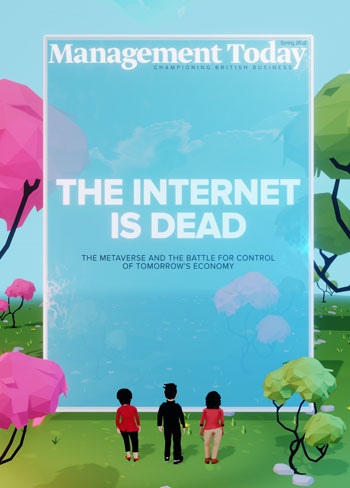
These terms hit the mainstream after Facebook changed its name to Meta in October 2021 and announced plans to invest “heavily” in the area. The metaverse refers to a network of interactive, immersive, socially-connected virtual worlds - a sort of 3D internet. Web3 is the supposed next iteration of the internet that will redistribute power from “Big Tech” companies to “the people” through decentralisation - where platforms are owned by the community, not a dominant player.
Both concepts are in their infancy. But glimpses of the metaverse can be seen in the walled garden platforms created by tech companies. For example, Microsoft’s Mesh technology, which Accenture has used to create an amusement park-like space to onboard staff. Or Cisco’s creation of photorealistic 3D holograms to use in virtual meetings.
It’s also on show in the decentralised platforms - Decentraland and The Sandbox are the two largest. They have already played host to a wide range of brands dipping their toes in the virtual water.
Is there an opportunity for publishers?
For every fan of these concepts, there is an equally impassioned sceptic. Some analysts are bullish. Gartner predicts that one in four people will spend an hour a day in the metaverse by 2026, while crypto investment firm Grayscale believes the metaverse is a $1tn revenue opportunity.
Others believe history is repeating itself, citing Second Life’s failure to be a current force in popular culture. The Register (reappropriating author Douglas Adams) dismissed Web3 as “a fairy story. It’s what parents tell their kids about at night if they want them to grow up to become economists.”
Whatever unfolds, publishers will always need to stay close to their audience. And perhaps the strongest argument to pay attention is that these spaces may be particularly important to connect with a generation already growing up in virtual worlds like Fortnight, Minecraft and Roblox - one of the major future consumer groups.
“The metaverse - and Web3 more generally - is in that place that you often see with new technologies. It’s either seen as the thing that will change all of our worlds or a hyped-up fad that will fizzle out as quickly as it arrived. The reality is that no-one knows for sure where it will land - and it may well be that it ends up being somewhere in the middle as neither saviour nor squib,” says digital media consultant Martin Ashplant, who has led digital teams at Metro, City AM and New Statesman Media Group.
David Tomchak, the founder of Artificial Intelligence and Web3 In Media, and a former Evening Standard digital publisher, agrees that no-one can accurately predict what will happen, but believes the fundamentals are favourable. “There's huge investment in the area, a cultural drive towards new things, better connectivity, a lower barrier to entry on the cost of hardware, an appetite for virtual spaces and the advent of quantum computing, which would open up the use of data significantly. So I would suggest that people will be there. One would hope that publishers can take advantage of that because there’s definitely an opportunity for them.”
He adds, it’s important for the publishing industry, which he says was slow to catch on to the mobile, social and digital revolutions, not to repeat its mistakes and be left playing catch-up.
The prize for publishers is, in some cases, money. For others it’s about expanding audience reach. The technology offers the ability to tell richer stories through immersive experiences and to co-create with an audience. Experimenting at an early stage can help companies upskill teams, understand how the spaces operate and test approaches with low risk. It also helps position a company as forward-thinking.
How are publishers currently approaching it?
Much of the initial experimentation has focused on non-fungible tokens (NFTs). TIME launched an NFT business called TIMEPieces, which has sold more than 20,000 NFTs since September 2021, generating a $10million profit. These NFTs give readers unlimited access to TIME’s content, as well as exclusive access to virtual and in-person events.
Other media outlets have also experimented; Dazed, Evening Standard and The Economist have all issued NFTs in the past year.
Then there are those that have set up a presence in the decentralised metaverse platforms. Earlier this year, the South China Morning Post built an immersive experience in The Sandbox, which teleported visitors back in time to complete quests and learn about the history of the Hong Kong Star Ferry.
Back in April, my own magazine, Management Today, recreated its front cover as a 12-metre-high building in Decentraland with clickable portals for users to read our magazine (see box for details). In June, TIME launched TIME Square, a space in The Sandbox to host virtual art and commerce events.
Others are exploring the potential behind the scenes. Tomchak is leading a pilot with partners including WAN-IFRA (The World Association of Newspapers and News Publishers) to create a blueprint for how publishers can work with Web3 technologies. The pilot will be expanded in the new year. Publishers can still take part.
The pitfalls
Like any new technology, publishers need to carefully consider the risks before jumping in. The obvious one is environmental concerns; some brands have already suffered backlash after making public commitments to sustainability while using energy-guzzling blockchains. Although changes are being made to reduce the future energy consumption of blockchains, it is still an important point to consider.
There are also safety concerns over poor behaviour on these platforms and the erosion of trust. “It’s so easy to do deep fakes or to create virality around things that are negative,” says Tomchak.
Then there’s the more fundamental problem of meaningless activity and wasting money. Publishers need to consider why they want to be there in the first place.
Creating an engaging presence in the metaverse takes time - don’t just try to repurpose existing work. “The Web2 equivalent would be taking a TV show and sticking it on LinkedIn or Facebook, or just cutting it up for Instagram reels. That clearly does not connect with audiences in those spaces,” says Tomchak.
Understanding what people want from these spaces is critical to success, says Dazed’s brand strategy director, Izzy Farmiloe. When Dazed released an NFT of its front cover featuring Rhianna wearing a spliff costume in September 2021, it did so as a competition. It asked entrants to tell them why they wanted to win the NFT cover, which gave them critical insight into their readers’ motivations. “Mostly, people wanted to have the NFT as an investment, or to gift it to other people. Gifting is a huge driver of virtual goods,” says Farmiloe.
Tomchak believes working in this space will require a more collaborative mindset, something the competitive publishing industry rarely demonstrates. “People who are credible in this space are prepared to collaborate in a harmonious and equitable manner,” he says. Perhaps driven by the fact that luxury brands are one of the most active groups in the space, Vogue has set up a Web3 team to explore the area and take advantage of partnership opportunities. “Partnering with another industry that’s thinking ahead has been quite clever because it means they’ve been able to learn quickly,” says Tomchak.
Taking the first step
An important first step is to prepare your business to be blockchain-ready. Can your business accommodate the cryptocurrencies that decentralised platforms use? If so, what are the tax and security implications? Do you have the internal skills to create immersive digital experiences? How does your trademarking work in virtual spaces? How would you monetise it? How do you protect your brand in a space you don’t own?
Tomchak urges publishers to “play around in the space”. He says: “Open up a wallet, figure out how your CMS might be able to interact with it. Ask your head of tech engineering if a metamask will fit with your site.”
But Farmiloe says before publishers even start thinking about the metaverse, they should improve their current digital experience. “That could be as simple as starting with optimising your website or making really exciting, interesting mobile and online experiences,” she says. Her research shows that metaverse experiences are about escapism and social connection. So, she argues publishers should be employing meta or gaming natives: “Learn from what’s working at the moment, bring in the right people and make sure they are leading and you’re not dictating to them.”
So, if you are a media brand with the time, money or resources, or an early adopter audience, it might be worth experimenting. If not, it is at least worth keeping a watchful eye on developments. For, as Ashplant puts it, “If publishers had decided to ignore the mobile internet at the point when it was similarly nascent, they would have had plenty of time to regret that decision.”
How we put Management Today in the metaverse

Management Today wanted to investigate whether the metaverse was something its audience of senior business leaders should take seriously. To enrich our storytelling, give the brand more credibility on the topic and offer practical advice to our audience, we decided to go into the metaverse ourselves.
I approached the creative digital agency R/GA and persuaded them to work with us on the initiative for free - they normally charge £50k for this type of work. We recreated MT’s front cover in Decentraland. We chose this platform because it was the most flexible to work in, but more importantly, our readers could access it for free on their desktops (no clunky VR headsets required).
All the land in Decentraland is owned by virtual landlords - you have to pay to rent the space. We built our 12-metre-high cover on one of R/GA’s 16x16m plots of land. The height adhered to the planning rules that dictate what you can do on the differently sized plots. We wrote a provocative cover line “The internet is dead” to attract attention. The image of our cover in the metaverse became the print and digital cover of the next magazine (a “meta, meta” cover).
Brands must earn the right to be present in community-owned spaces. One way to do this is to provide utility. So we embedded clickable portals on our cover that would transport the user’s avatar to other notable experiences in the platform, such as the Australian Open stadium. We also put a link to a virtual-page turner of our subscriber-only magazine, which we made free to Decentraland users.
Page views of the relevant digital magazine were 150% higher than previous editions. Our articles on the topic generated more traffic and engagement than our average stories.
This article was first published in InPublishing magazine. If you would like to be added to the free mailing list to receive the magazine, please register here.










